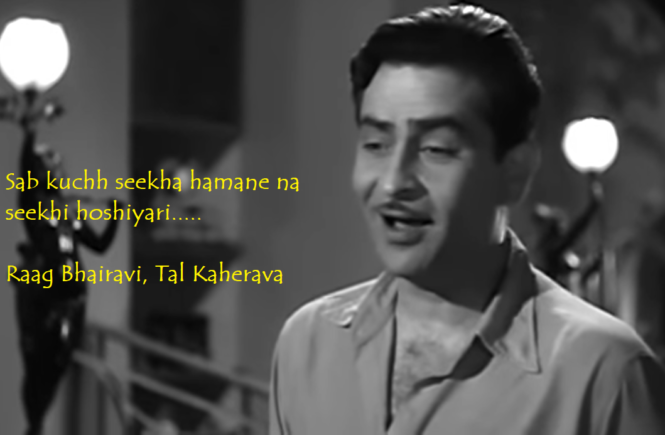Raaga Based Song of the Day: Sab kuchh seekha hamane na seekhi hoshiyari ….
Raag Bhairavi, Tal Kaherava
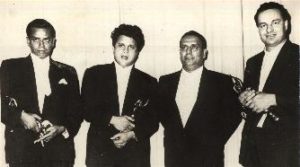
Ladies and gentlemen, tonight I give you, as promised earlier, pièce de résistance of a song in Raag Bhairavi, Tal Kaherava. As you can make out in the accompanying picture, this is from the team of Lyricist Shailendra, Music Duo Shankar Jaikishan and Singer Mukesh. First about Jaikishan. Raag Bhairavi was his favourite raaga to compose songs in. He was so fond of composing in this raag that many of S-J’s movies had more than one song composed in Bhairavi; indeed, many had four to five songs in the same raag. The song I am taking up today is from the 1959 Hrishikesh Mukherjee movie Anari. In addition to this song in Raag Bhairavi sung by Mukesh, there was another beautiful number in the same raag in the movie, sung by Lata Mangeshkar: Tera jaana dil ke armaano ka lut jaana.
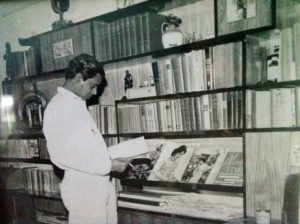
Now about Lyricist Shailendra (Please see: ‘The Best Song Of Shailendra, The Lyricist Beyond Compare – Part I‘ and ‘The Best Song Of Shailendra, The Lyricist Beyond Compare – Part II‘). When the Filmfare award for best lyricist was introduced, Shailendra was the first one to win it in 1958, for his Yahudi song: Yeh mera deewanapan hai. Next year, he again won the same award for this song. Finally, he won it in 1968 for his Brahmachari song: Main gaayun tum so jao. His songs often had that deep meaning attribute that was best seen in the songs of the movie that he produced: Teesri Kasam (songs such as: Sajan re jhoot mat bolo khuda ke paas jaana hai), Duniya banane waale kya tere man mein samaayi, and Sajanva bairi ho gaye hamaar). The failure of this movie led to his death, at a very young age of 43 years on 14 Dec 1966 and we lost one of the best lyricists in Hindi films.
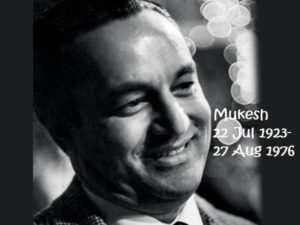 As far as singer Mukesh Chand Mathur is concerned, he was best known as the singing voice of actor Raj Kapoor though he sang for Manoj Kumar, Sunil Dutt, and even Dilip Kumar, amongst others. This song is a remarkably unique song as seen in the picture; it won Filmfare Awards for all three associated with the making of the song: Lyricist Shailendra, Composer Shankar Jaikishan and Singer Mukesh. Mukesh won Filmfare Awards for Best Singer four times: three times for songs composed by Shankar Jaikishan (the other two times for singing for Manoj Kumar) and once with Khayyam in the title song of Kabhi KabhiThe song was selected by me as my profile song as it best describes my own feelings.
As far as singer Mukesh Chand Mathur is concerned, he was best known as the singing voice of actor Raj Kapoor though he sang for Manoj Kumar, Sunil Dutt, and even Dilip Kumar, amongst others. This song is a remarkably unique song as seen in the picture; it won Filmfare Awards for all three associated with the making of the song: Lyricist Shailendra, Composer Shankar Jaikishan and Singer Mukesh. Mukesh won Filmfare Awards for Best Singer four times: three times for songs composed by Shankar Jaikishan (the other two times for singing for Manoj Kumar) and once with Khayyam in the title song of Kabhi KabhiThe song was selected by me as my profile song as it best describes my own feelings.
We have completed seventy-eight days of Raaga Based Songs of the Day. Our first post in the series was titled ‘Raaga Based Song Of The Day #1’ and the song was a Mohammad Rafi and Lata Mangeshkar song from the 1970 Shakti Samanta movie Pagla Kahin Ka: Tum mujhe youn bhula na paoge. It is in Raag Jhinjhoti, Tal Kaherava.
Our seventy-eighth post or the last post was titled ‘Raaga Based Song Of The Day #78’ and the song was a Lata Mangeshkar song from the 1971 Sunil Dutt movie Reshma Aur Shera starring Sunil Dutt and Waheeda Rehman: Tu chanda main chandani. It is in Raag Mand, Tal Kaherava.
This blog has a number of posts on Raaga based songs in Hindi movies titled similarly; for example: ‘The Best Raaga Based Songs in Hindi Movies – Raaga Bhimpalasi – Part II‘.
In the last seventy-eight days of sharing Raaga based songs of the day, I have given you songs based on Raag Jhinjhoti, Gara, Bhimpalasi, Madhuvanti, Shivaranjani, Bihag, Pahadi, Sarang, Pilu, Bhairavi, Khammaj, Charukesi, Kalyan or Yaman, Desh, Malgunji, Kirwani, Kedar, Bageshri, Megh Malhar, Bhupali, Ahir Bhairav, Malkaush, Mand, Adana, Kafi, Rageshri, Jaunpuri, Tilang, Janasammohini, Chayanat, Shuddha Kalyan, Gaur Sarang, Jogiya, Asavari, Maru Bihag, Durga, Lalit, Puria Dhanashri, Bhinna Sahdja, Sohani, Multani, Patdeep, Jaijaiwanti, Tilak Kamod, Hemant, Basant Mukhari, Gujri Todi, Kalavati, Hamir, Bhatiyar, Gawati, Shyam Kalyan, Gorakh Kalyan, Madhamat Sarang, Manj Khammaj, Darbari Kanada, Vibhas, Shankara, Bahar, Nand and Mian Ki Malhar; making it a total of 61 raagas. The raagas that have been repeated so far are Pahadi, the raaga of my home place in the Himalayas, Maru Bihag, Raag Kirwani, Jhinjhoti, Bhairavi, Gara, Basant Mukhari, Malkauns, Bhairavi and Mand. Today, I am repeating Raaga Bhairavi again.
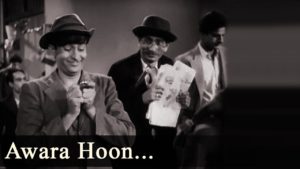
Today’s song has been sung by Mukesh on the lyrics of Shailendra and composition by Shankar Jaikishan. As I said, it is in Raag Bhairavi, Tal Kaherava. Finally, lets talk a bit about title songs of Raj Kapoor movies. Raj Kapoor was famous for giving us a song containing the title of the movie that he acted in. Hence, there was a song: Awara hoon from 1951 movie Awara. This song became an international hit and was also in Raag Bhairavi. Then there was Barsaat mein hamase mile tum sajan from 1949 movie Barsaat, also in Raag Bhairavi. The song we are taking up tonight is from 1959 movie Anari and has the title of the movie in the mukhada. It also is in Raag Bhairavi. Even the song Satyam Shivam Sundaram had the title of the 1978 movie Satyam Shivam Sundaram in it, though composed in Darbari Kanada by Laxmikant Pyarelal after Jaikishan was no more. The song Mera naam Raju gharana anaam had the name of the 1960 movie Jis Desh Mein Ganga Behati Hai and was also in Raag Bhairavi. One can safely conclude that it was more of a rule than exception.
Before we actually take up the song, first, lets take up the value added learning of today. We have already taken up quite a few Tala or Taals or Tals. Today, we shall take up Ektal. We took up a song in this tal on the 47th day: Man Mohana bade jhuthe. It was in Raag Jaijaivanti. The 1956 movie Basant Bahar’s best song Ketaki, gulab, juhi, champak ban phule was also in Ektal.
Ektal is a very popular tal. It is common in classical music such as the khayal, and semiclassical forms such as Rabindra Sangeet.
It has a simple structure: 12 matras divided into of six vibhags of two matras each. Its clapping arrangement is clap, tap, wave, tap, clap, tap, wave, tap, clap, tap, clap ,tap.
It is most associated with the khayal style of singing. A particular movement known as bada kheyal or vilambit kheyal is performed almost exclusively in very slow ektal. However, ektal is also performed in fast khayal as well.
The name “ektal” literally means “one-clap”. How the name came is a mystery since it has four claps:
clap, 2, wave, 2, clap, 2, wave, 2, clap, 2, clap, 2
The Theka is:

As I said, today’s song is in Raag Bhairavi, Tal Kaherava.
Raag Bhairavi is the basic raag of the Bhairavi Thaat. Bhairavi makes use of all the komal swars, Rishabh, Gandhar, Dhaivat, Nishad. When singing compositions in Bhairavi raag, the singers however take liberty to use all the 12 swars. Bhairavi raag is named after the shakti or feminine aspect of the cosmic life force, which is personified as a consort to Lord Shiva. Bhairavi is a powerful raag filled with devotion and compassion. Its Jati is Sampurna – Sampurna, which means all seven swar (heptatonic) both in Aaroha and Avaroha. I have already told you that in a concert Bhairavi is usually the concluding raaga since it is supposed to cure mistakes of the earlier performances. Hence, if a concert has started at night (which is usually the case), Bhairavi would be played in the wee hours of the morning.
A pleasant sobering atmosphere full of love and piety is created with this raag and one feels so close to the Supreme. Its compositions include several Thumris, Bhajans, Ghazals, Songs etc. Since it is an ocean of immense possibilities the melodic combinations can include all the twelve notes with skill.
I am not giving you again a list of songs composed in Raag Bhairavi as I have already given you this elsewhere.
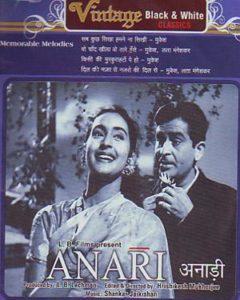 The song Sab kuchh seekha hamane na seekhi hoshiyari is from the 1959 Hrishikesh Mukherjee movie Anari starring Raj Kapoor and Nutan. It received five Filmfare awards, three for this song: Lyricist, Singer and Composer. The others were: Actor Raj Kapoor and Supporting Actress Lalita Pawar.
The song Sab kuchh seekha hamane na seekhi hoshiyari is from the 1959 Hrishikesh Mukherjee movie Anari starring Raj Kapoor and Nutan. It received five Filmfare awards, three for this song: Lyricist, Singer and Composer. The others were: Actor Raj Kapoor and Supporting Actress Lalita Pawar.
Please enjoy in Raag Bhairavi, Tal Kaherava: Sab kuchh seekha hamane na seekhi hoshiyari…….
Sab kuchh siikhaa hamane naa siikhii hoshiyaarii
Sach hai duniyaavaalo.n ki ham hai.n anaa.Dii
Duniyaa ne kitanaa samajhaayaa
Kaun hai apanaa kaun paraayaa
Phir bhii dil kii choT chhupaa kar
Hamane aapakaa dil bahalaayaa
Khud pe mar miTane kii ye zid thii hamaarii (2)
Sach hai duniyaavaalo.n ki ham hai.n anaa.Dii
Asalii nakalii chehare dekhe
Dil pe sau sau pahare dekhe
Mere dukhate dil se puuchho
Kyaa kyaa khvaab sunahare dekhe
TuuTaa jis taare pe nazar thii hamaarii (2)
Sach hai duniyaavaalo.n ki ham hai.n anaa.Dii
Dil kaa chaman uja.Date dekhaa
Pyaara kaa ra.nga utarate dekhaa
Hamane har jiine vaale ko
Dhan daulat pe marate dekhaa
Dil pe marane vaale mare.nge bhikhaarii (2)
Sach hai duniyaavaalo.n ki ham hai.n anaa.Dii
https://www.youtube.com/watch?v=OLZoBJxlQBA
We have intended to learn about Raaga based music whilst we entertain ourselves with Raaga based songs. So, lets, once again, take stock of our collective learning so far:
- On the first day we learnt about the Raaga system devised by Pandit Vishnu Narayan Bhatkhande, which is the prevalent system in Hindustani Classical Music and based on ten Thaats.
- On the second day we learnt about Tal or Taal.
- On the third day we learnt about characteristics of Raagas that included Swar, Jati, Thaat, Arohana and Avarohana, Vadi, Samvadi and Pakad.
- On the fourth day, we learnt about Sargam.
- On the fifth day, we learnt about notations used in Indian classical music or simply Swar Lipi.
- On the sixth day, we learnt about the Ras (sentiments) that Raagas evoke.
- On the seventh day, we learnt about various types of Swar: Shuddha, Achal, Vikrut, Komal and Teevra.
- On the eighth day, we learnt the parts of a composition in Indian Classical Music.
- On the ninth day, we learnt the names of some of the popular instruments used in Indian Classical Music.
- On the tenth day, we learnt about the sources of names of Raagas.
- On the eleventh day, we learnt about why Bhairavi is the first raag to be taught to beginners and also why it is the last in a performance.
- On the twelfth day, we learnt about Khammaj Thaat.
- On the thirteenth day, we learnt about Tal Punjabi Theka or Sitarkhani.
- On the fourteenth day, we learnt about Alap.
- On the fifteenth day, we learnt about List of Raagas (Raagmala) in my favourite book: Sri Guru Granth Sahib.
- On the sixteenth day, we learnt about tips for raaga identification.
- On the seventeenth day, we learnt the basics of Gharana system.
- On the eighteenth day, we learnt about Filmi Sangeet.
- On the nineteenth day, we learnt about the commonest Tal in Raagas: Tintal.
- On the twentieth day, we learnt about the Kafi Thaat.
- On the twenty-first day, we learnt a little more in detail about the classification of Raagas.
- On the twenty-second day, we learnt the essential differences between Bhairavi and Bhairav.
- On the twenty-third day, we learnt a little more in detail about the Jati or Jaati of a raaga.
- On the twenty-fourth day, we learnt details of Thaat Bilawal, the most basic thaat in the Bhatkhande’s system of raagas.
- On the twenty-fifth day, we learnt about Tintal.
- On the twenty-sixth day, we learnt in detail about the Raaga – Samay linkage.
- On the twenty-seventh day, we learnt about Lehar.
- On the twenty-eighth day, we learnt about the history of the Hindustani Music.
- On the twenty-ninth day, we learnt about Dhrupad.
- On the thirtieth day, we learnt about Rupaktal that I was introduced to, a few months back, by my friend Anand Desai.
- On the thirty-first day, we learnt about Khayal.
- On the thirty-second day, we learnt about Thumri.
- On the thirty-third day, we learnt about Tappa.
- On the thirty-fourth day, we learnt about Tarana.
- On the thirty-fifth day, we learnt about Tal Dipchandi (Moghali).
- On the thirty-sixth day, we learnt about Tabla.
- On the thirty-seventh day, we learnt about Kirtan.
- On the thirty-eighth day, we learnt about Pakhawaj.
- On the thirty-ninth day, we learnt about Hori.
- On the fortieth day, we learnt about Dadra.
- On the forty-first day, we learnt about Kajri.
- On the forty-second day, we learnt about Chaiti.
- On the forty-third day, we learnt about Sarangi.
- On the forty-fourth day, we learnt about Shehnai.
- On the forty-fifth day, we learnt about Sarod.
- On the forty-sixth day, we learnt about Bansuri.
- On the forty-seventh day, we learnt about Ektal and Tanpura.
- On the forty-eighth day, we learnt about Veena.
- On the forty-ninth day, we repeated our learning of Veena with a small excitement added.
- On the fiftieth day, we learnt about Dilruba/Esraj.
- On the fifty-first day, we learnt about Jaltarang.
- On the fifty-second day we learnt about Qawwali.
- On the fifty-third day, we learnt about Sitar.
- On the fifty-fourth day, we learnt about Surbahar.
- On the fifty-fifth day, we learnt about Harmonium.
- On the fifty-sixth day, we learnt about Santoor.
- On the fifty-seventh day, we learnt about Swarmandal.
- On the fifty-eighth day, we learnt about the Shruti Box.
- On the fifty-ninth day, we learnt about Alankar.
- On the sixtieth day, we learnt about singing in Aakaar.
- On the sixty-first day, we learnt about the Classification of Indian Musical Instruments.
- On the sixty-second day, we learnt a little about Carnatic Music.
- On the sixty-third day, we learnt about Natya Shastra.
- On the sixty-fourth day, we learnt about evolution of musical instruments in India down the ages.
- On the sixty-fifth day, we learnt about Riyaaz.
- On the sixty-sixth day, we looked at a list of Raagas in Hindustani Classical Music.
- On the sixty-seventh day, we learnt about the health benefits of raagas.
- On the sixty-eighth day, we learnt a little more comprehensively about the moods and emotions that raagas evoke.
- On the sixty-ninth day, we learnt about a mobile application to help identify raagas.
- On the seventieth day, we learnt about Melakarta Raagas.
- On the seventy-first day, we learnt about Sangita Makarand.
- On the seventy-second day, we learnt about TaalMala an Android application for personalized accompaniment of musical instruments during Riyaaz or even during Concert.
- On the seventy-third day, we learnt about Indian Classical Ragas, an Android application for mobile phones.
- On the seventy-fourth day, we learnt about Saregama Classical, another application for Classical Raagas.
- On the seventy-fifth day, we learnt about a free online service available to learn Indian Classical Music.
- On the seventy-sixth day, we learnt about List of Hindustani Classical Musical Festivals in India and Abroad.
- On the seventy-seventh day, we learnt about List of Carnatic Musical Festivals in India and Abroad.
- On the seventy-eighth day, we learnt about Jhaptal.
- And today, on the seventy-ninth day, we learnt about Ektal.
There is much more still to be learnt and enjoyed.
Please stay tuned!
